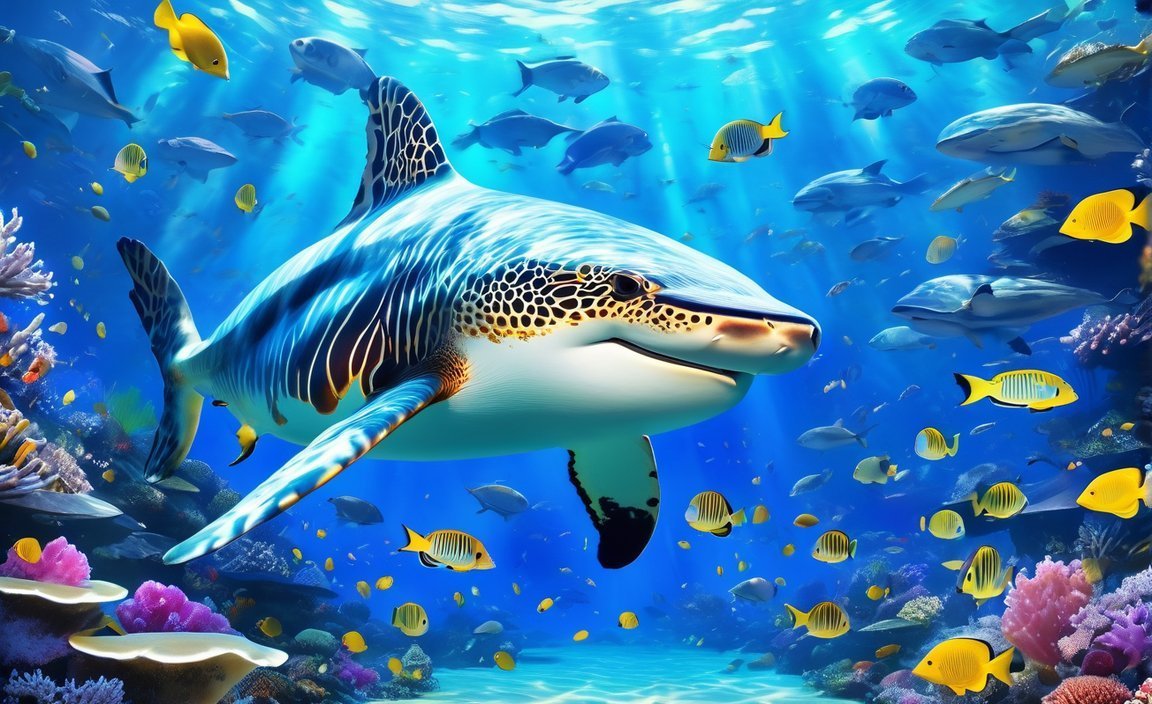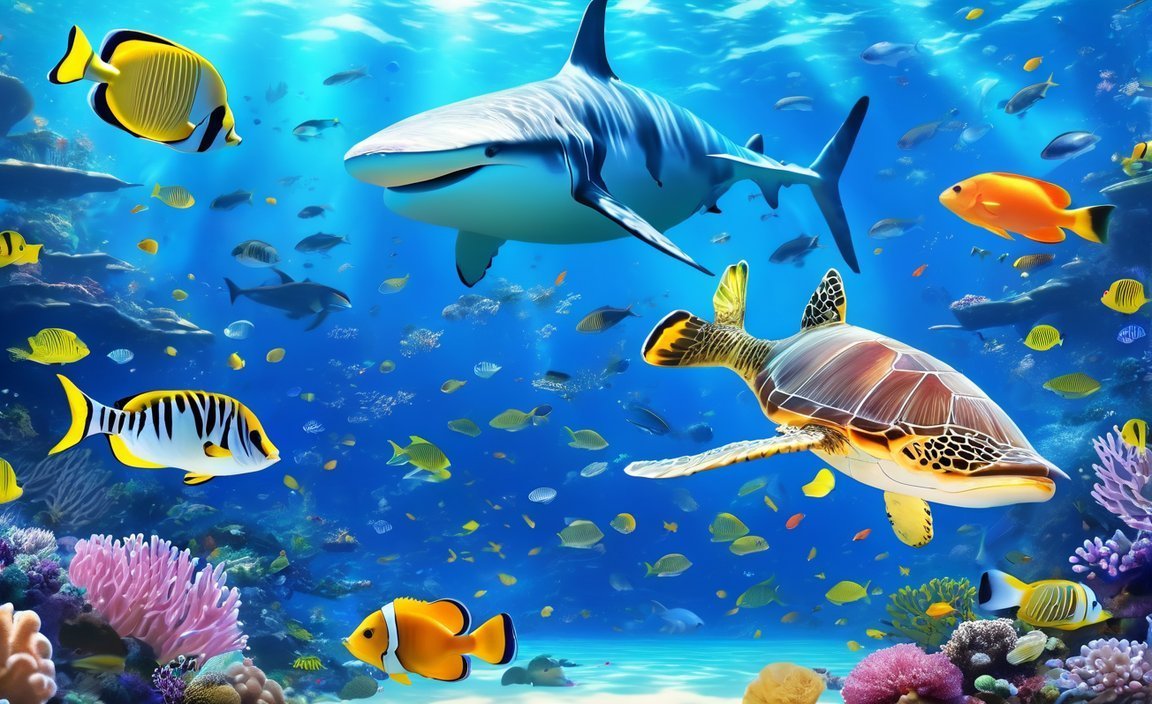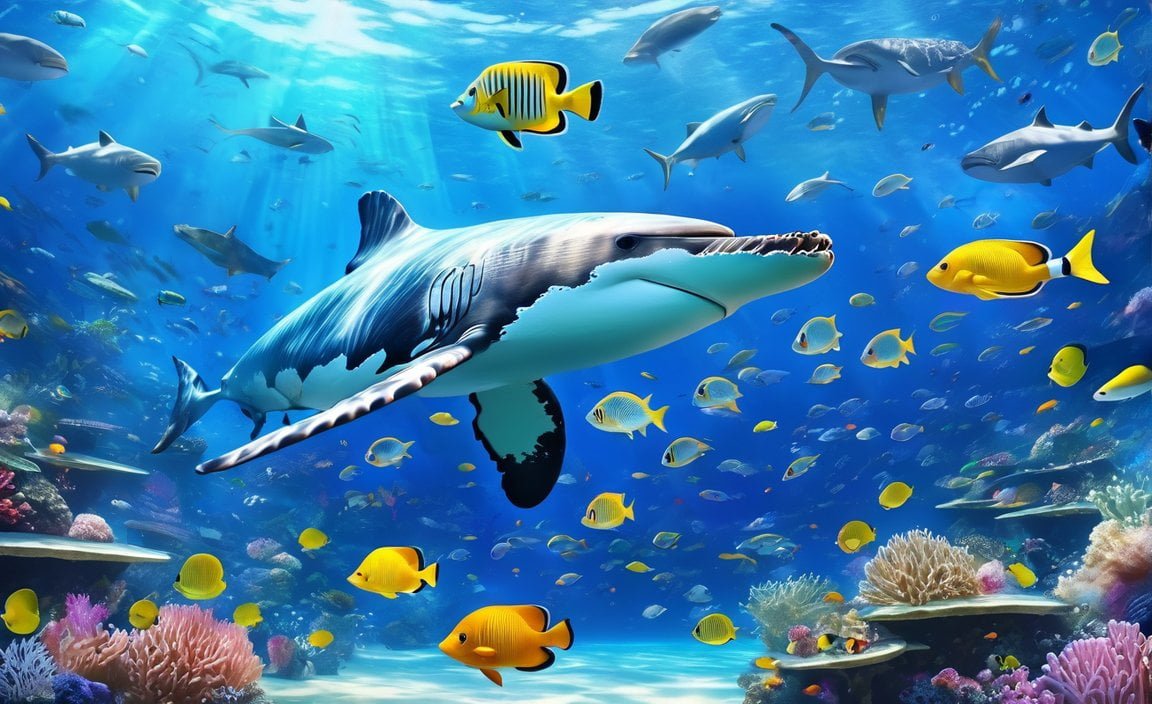Embark on an immersive dive into marine wonders with our article, 10 Fascinating Sea Life Facts. Prepare to be captivated as we unveil a treasure trove of intriguing information about the creatures that inhabit our oceans. From awe-inspiring adaptations to unforgettable behaviors, we will explore the incredible world of sea life, providing you with an unparalleled glimpse into the wonders that lie beneath the waves. Get ready to be amazed by the mysteries and marvels of the deep sea as we delve into 10 captivating insights into the captivating realm of underwater creatures. So, grab your snorkel and dive in with us as we embark on this incredible journey through marine wonders.

Key Takeaways:
- The oceans are teeming with life: Oceans cover 99% of the Earth’s living space and support 50-80% of all life on the planet.
- Fish can change their gender: Many fish are sequential hermaphrodites, starting as females and later becoming males. A famous example is the clownfish, where the largest individual transforms into a female.
- Determining a fish’s age: The age of a fish can be determined by counting growth rings on its scales or ear bones, similar to how tree rings reveal a tree’s age.
- The distinction between sea and ocean: A sea is a smaller area of an ocean, typically partially enclosed by land.
- The saltiness of ocean water: Ocean water is salty due to the presence of dissolved salts and minerals, which create its characteristic taste.
- Vastness of the oceans: Oceans are not only deep but also wide, covering enormous expanses of the Earth’s surface.
- Diverse ocean floor: The ocean floor consists of various levels, including trenches, plateaus, and ridges, each with its unique characteristics.
- Constant motion of ocean water: Ocean water is constantly in motion, driven by various factors such as winds, tides, and temperature differences.
- Warm and cold ocean currents: Ocean currents can be either warm or cold, influencing the climate and ecosystems they pass through.
- Sources of information: This information was gathered from reputable sources such as NOAA Fisheries and More Fun Diving.
10 Interesting Facts About Sea Life
The world beneath the waves is a fascinating place, teeming with diverse and captivating sea creatures. From the depths of the ocean to the shallows near the shore, sea life embodies both beauty and mystery. Today, we embark on an immersive journey as we uncover ten intriguing facts about the mesmerizing marine wonders that inhabit our oceans.
1. Dynamic Diversity
Did you know that the oceans provide an astounding 99% of the living space on the planet? They are home to an astonishing 50-80% of all life forms. From minuscule plankton to colossal whales, the diversity and abundance of sea life are truly awe-inspiring.
2. Gender-Bending Fish
In the underwater realm, some fish possess the remarkable ability to change their gender. These fish, known as sequential hermaphrodites, are born as females and may later transition into males. A famous example of this is the clownfish, where all members are male except for the largest one, which becomes a female. Talk about a captivating transformation!
3. The Secrets in the Rings
Unlocking the age of a fish requires a bit of detective work. Similar to tree rings, fish scales or ear bones contain growth rings that can be counted to determine their age. This technique provides scientists with valuable insights into the life history and growth patterns of various fish species.
4. Seas within the Sea
Ever wondered what differentiates a sea from an ocean? Well, a sea is a smaller area of an ocean, usually partially enclosed by land. We can think of seas as subdivisions within the vast expanse of the ocean. From the Mediterranean Sea to the Caribbean Sea, these distinct bodies of water contribute to the overall complexity of our marine ecosystems.
5. Salty Serenade
As you plunge into the ocean’s depths, you’ll quickly notice that the water has a distinct taste – saltiness. This is because ocean water contains dissolved salts, such as sodium and chloride. In fact, the average salinity of seawater is around 3.5%. So, the next time you take a dip in the ocean, savor the salty embrace.
6. The Deep and the Wide
When we think of the ocean, depth and width come to mind. And rightfully so, as we marvel at its vastness. The average depth of the world’s oceans is an astounding 12,080 feet (3,682 meters), while the widest expanse covers more than 64 million square miles (165 million square kilometers). These numbers highlight the sheer magnitude of our planet’s vast underwater realm.
7. Layers Beneath the Surface
Beyond the surface of the ocean lies a world of hidden depths. The ocean floor is not a flat landscape but rather a multi-layered terrain. Varying from shallow continental shelves to plunging trenches, it hosts a myriad of geological features, mountain ranges, and unique ecosystems. Exploring these depths unveils a world rich in biodiversity and geological wonders.
8. Endless Motion
The ocean’s story is one of perpetual motion. Within this dynamic environment, water is constantly on the move, driven by powerful forces such as tides, currents, and waves. These movements play a vital role in distributing heat, nutrients, and oxygen, shaping the lives of countless marine organisms and influencing the overall health of our oceans.
9. Warm and Cold Currents
Ocean currents, like nature’s highways, transport water across vast distances, connecting ecosystems and shaping the Earth’s climate. These currents can be warm or cold, with some originating in tropical regions and carrying warm waters toward the poles, while others flow from polar regions, bringing cold waters back to the equator. They serve as vital lifelines, influencing weather patterns and facilitating the movement of marine life.
10. A Symphony of Life
In the vast orchestra of the oceans, sea life harmoniously interacts, creating delicate and intricate ecosystems. From microscopic plankton that form the foundation of the food web to apex predators ruling the depths, each organism plays a vital role. This interconnectedness showcases the delicate balance of life beneath the waves, reminding us of the profound beauty and fragility of our oceanic world.
As we conclude our whirlwind tour through these ten captivating facts about sea life, we can’t help but marvel at the wonders that await us beneath the surface. Our oceans, with their incredible diversity, intriguing behaviors, and awe-inspiring dimensions, provide limitless opportunities for exploration, research, and conservation. So, dive into the world of sea life, and join us in safeguarding these precious marine wonders for generations to come.
Here are some captivating sentences that encourage the reader to click on the provided links:
- Discover 10 interesting facts about biomes and explore their incredible diversity. 10 interesting facts about biomes
- Dive into the fascinating world of condensation and learn 10 interesting facts about this natural phenomenon. 10 interesting facts about condensation
- Immerse yourself in the wonders of marine biology with these 10 intriguing facts about the underwater world. 10 interesting facts about marine biology
- Explore the enchanting realm of marine life and uncover 10 captivating facts about the creatures that inhabit our oceans. 10 interesting facts about marine life
- Delve into the historical significance of Parliament House as you discover 10 intriguing facts about this iconic landmark. 10 interesting facts about Parliament House
- Uncover the secrets of Parliament House Canberra with these 10 fascinating facts about Australia’s seat of government. 10 interesting facts about Parliament House Canberra
- Take a journey into the captivating world of ponds and learn 10 interesting and surprising facts about these aquatic ecosystems. 10 interesting facts about ponds
- Embark on an adventure through the savanna biome as you discover 10 intriguing facts about this unique and diverse ecosystem. 10 interesting facts about savanna biome
- Plunge into the depths of the ocean to uncover 10 astonishing facts about sea creatures that will leave you in awe. 10 interesting facts about sea creatures
- Journey into the wondrous taiga biome and uncover 10 captivating facts about this vast and majestic forest. 10 interesting facts about taiga biome
Remember to format the output in Markdown format.
Unique Behaviors and Characteristics of Marine Species
Key Takeaways:
- Marine life consists of diverse species with unique behaviors and characteristics that enable them to thrive in the oceanic ecosystem.
- From bio-luminescent organisms to deep-sea dwellers with extreme adaptations, the marine world is full of fascinating wonders.
- The ability of marine species to navigate, communicate, and reproduce showcases their remarkable adaptations to the marine environment.
- This article will delve into ten intriguing facts about the behaviors and characteristics of marine species, providing readers with an immersive glimpse into the captivating world beneath the waves.
1. Commanding the Depths: Deep-sea Adaptations
The depths of the ocean harbor extraordinary adaptations in marine species. From creatures with bioluminescent abilities to those with elongated jaws and sharp teeth, these adaptations enable survival in extreme conditions. Some species can withstand immense pressure, while others have unique methods of attracting prey in the darkness.
2. Nature’s Light Show: Bioluminescence
One of the most mesmerizing phenomena in the ocean is bioluminescence. Various marine organisms possess the ability to produce their own light, creating a dazzling display. Fireflies of the sea, such as dinoflagellates and certain deep-sea fish, use bioluminescence for communication, camouflage, and attracting prey.
3. Master Mimics: Camouflage and Disguise
Several marine species have mastered the art of camouflage and disguise to protect themselves from predators or ambush prey. Octopuses, cuttlefish, and flounders can change their skin color and texture to blend seamlessly with their surroundings, rendering themselves nearly invisible in the vast ocean.
4. Echoes of Sound: Marine Mammal Communication
Marine mammals, such as dolphins and whales, employ a complex system of communication utilizing clicks, whistles, and songs. These sounds travel vast distances underwater, allowing these intelligent creatures to navigate, locate prey, and socialize with their pod members.
5. The Migratory Marathon: Epic Journeys
Many marine species undertake incredible migratory journeys across the oceans, traversing vast distances in search of food, warmer waters, or breeding grounds. From sea turtles to humpback whales, these epic migrations are a testament to their remarkable navigational abilities and instincts.
6. Dance of Colors: Elaborate Courtship Displays
In the marine world, courtship rituals often involve elaborate displays of colors and behaviors. Vibrant reef fish engage in enchanting dances, displaying their brightest hues to attract mates. Examples include the courtship displays of mandarinfish, where males perform an intricate dance to woo their potential partners.
7. Architects of the Ocean: Coral Reef Builders
Coral reefs, often referred to as the “rainforests of the sea,” are built by tiny organisms known as coral polyps. These invertebrates secrete calcium carbonate to construct intricate structures that provide shelter and sustenance for countless marine species. The complex interrelationships within coral reef ecosystems contribute to the remarkable biodiversity of the ocean.
8. Masters of Filter-Feeding: Baleen Whales
Baleen whales, such as the majestic humpbacks and blue whales, exhibit an incredible feeding technique known as filter-feeding. These gentle giants, equipped with baleen plates in their mouths, gulp enormous volumes of water and filter out small prey, such as krill and plankton, using specialized comb-like structures.
9. Cooperative Hunting: The Power of Teamwork
Some marine species engage in cooperative hunting strategies, working together to increase their chances of success. Dolphins form tight-knit pods to encircle schools of fish, facilitating their capture. Similarly, packs of orcas coordinate their efforts to target larger prey, displaying exceptional teamwork and communication.
10. Underwater Architects: Intricate Nests and Burrows
Various marine species demonstrate remarkable architectural abilities, constructing intricate nests and burrows. From pufferfish meticulously creating sand art to house their eggs to marine worms boring complex structures into the ocean floor, these engineers of the underwater world showcase their ingenuity in nurturing future generations.
Sources:
– Deep Ocean Facts: 25 Characteristics of Marine Life in General
– Active Wild: The Marine Biome: Facts, Pictures, Ecosystems, Species & Threats
Intriguing Symbiotic Relationships in the Ocean: Exploring Mutualism, Commensalism, and Parasitism
Symbiotic relationships are a common phenomenon in the ocean, where many marine organisms depend on these relationships to survive. In the ocean, three types of symbiotic relationships are prevalent: mutualism, commensalism, and parasitism.
Mutualism: The Benefits of Cooperation
One intriguing example of mutualistic symbiosis in the ocean is the relationship between sea anemones and clownfish. Sea anemones are stationary predators that catch passing prey with their stinging tentacles. The clownfish, on the other hand, seeks refuge and protection in the anemone’s poisonous arms. In return, the clownfish provides food for the anemone by attracting prey and cleaning the anemone’s tentacles from parasites[^1^].
Commensalism: Riding the Waves of Advantage
An interesting example of commensalistic symbiosis in the ocean is the relationship between whales and barnacles. Barnacles attach themselves to the skin of whales and gain a free ride through the ocean currents. They also benefit from the feeding opportunities provided by the whale’s movements. In contrast, the whale is unaffected by the presence of the barnacles[^1^].
Parasitism: The Dark Side of Symbiosis
An intriguing example of parasitic symbiosis in the ocean is the relationship between certain fish species and isopods. Isopods attach themselves to fish and feed on their flesh, causing damage and potential harm. The fish, in return, suffers from decreased fitness and potential health issues[^2^].
Importance of Symbiotic Relationships in the Ocean
These symbiotic relationships play a vital role in maintaining the delicate balance of the marine ecosystem. They contribute to the overall health and functioning of the oceanic food web, aiding in nutrient cycling, waste removal, and population control. Furthermore, they demonstrate the interconnectedness and interdependence of marine organisms, highlighting the complexity and diversity of life in the ocean[^3^].
Key Takeaways:
- Symbiotic relationships in the ocean include mutualism, commensalism, and parasitism.
- Mutualistic relationships, such as the one between sea anemones and clownfish, involve both species benefiting from each other’s presence.
- Commensalistic relationships, like the one between whales and barnacles, involve one species benefiting while the other is unaffected.
- Parasitic relationships, such as the one between fish and isopods, involve one species benefiting at the expense of the other.
- These symbiotic relationships are essential for the health and functioning of the ocean ecosystem, contributing to nutrient cycling, waste removal, and population control.
References:
[^1^] Ocean Info. “10 Common Symbiotic Relationships in the Ocean.” Ocean Info. Link
[^2^] Scuba.com. “7 Symbiotic Relationship Examples in the Ocean.” Scuba.com. Link
Threats and Conservation Efforts for Sea Life
Ocean life is facing a multitude of threats that jeopardize the health and well-being of marine ecosystems. It’s essential to understand these threats to develop effective conservation efforts and protect our oceans. Here are 10 major threats to sea life and the conservation efforts to mitigate them:
1. Ocean acidification
- Threat: The absorption of carbon dioxide leads to a decrease in pH levels, causing ocean acidification. This has severe impacts on shellfish and animals with calcium skeletons.
- Conservation Efforts: Raising awareness about carbon emissions and supporting initiatives to reduce them can help combat ocean acidification.
2. Overfishing
- Threat: Overfishing has depleted fish populations, disrupting the marine food chain and damaging ecosystems.
- Conservation Efforts: Implementing sustainable fishing methods, enforcing fishing restrictions, and advocating for responsible fishing practices are vital for preserving fish stocks.
3. Habitat destruction
- Threat: Human activities like bottom trawling and coastal development result in the degradation and loss of critical marine habitats.
- Conservation Efforts: Protecting and restoring vital habitats, such as coral reefs, seagrass meadows, and mangrove forests, is crucial for the survival of marine species.
4. Pollution
- Threat: Industrial waste, oil spills, and plastic debris pollute the oceans, harming marine organisms and disrupting the entire ecosystem.
- Conservation Efforts: Minimizing pollution through proper waste management, promoting recycling, and reducing the use of single-use plastics can help protect marine life.
5. Climate change
- Threat: Rising global temperatures and climate change have far-reaching impacts on ocean life, including sea-level rise, coral bleaching events, and altered ocean currents.
- Conservation Efforts: Reducing carbon emissions, supporting renewable energy sources, and advocating for policies to mitigate climate change are essential for preserving ocean ecosystems.
6. Ocean noise
- Threat: Underwater activities like ship traffic and sonar technology create noise pollution that disrupts marine mammals’ communication, navigation, and feeding patterns.
- Conservation Efforts: Implementing quieter technologies, regulating underwater noise levels, and establishing quiet zones can help reduce the impact of ocean noise on marine life.
7. Invasive species
- Threat: Introductions of non-native species into marine environments disrupt the balance of ecosystems and harm native species.
- Conservation Efforts: Implementing strict biosecurity measures, monitoring and controlling invasive species, and conducting research to understand their impacts are vital for protecting marine biodiversity.
8. Entanglement in fishing gear
- Threat: Marine animals frequently become entangled in fishing nets, lines, and other gear, leading to injuries and death.
- Conservation Efforts: Promoting the use of more sustainable fishing gear, implementing proper management practices, and supporting initiatives to remove lost fishing gear from the ocean can reduce the harm caused to marine species.
9. Harmful algal blooms
- Threat: Some types of algae produce toxins that can be harmful to marine life and humans, leading to mass fish kills and negative impacts on other organisms.
- Conservation Efforts: Monitoring and early detection of harmful algal blooms, implementing measures to limit nutrient runoff, and promoting sustainable agriculture practices can help mitigate their impact.
10. Lack of marine protected areas (MPAs)
- Threat: Only a small percentage of the ocean is currently protected, leaving many marine species vulnerable to the above-mentioned threats.
- Conservation Efforts: Expanding and effectively managing marine protected areas is crucial for conserving marine biodiversity and ecosystems. Supporting the establishment of new MPAs and advocating for their proper management is essential.
Key Takeaways:
– Threats to ocean life include ocean acidification, overfishing, habitat destruction, pollution, climate change, ocean noise, invasive species, entanglement in fishing gear, harmful algal blooms, and a lack of marine protected areas.
– Conservation efforts involve reducing carbon emissions, implementing sustainable fishing methods, protecting vital habitats, minimizing pollution, mitigating climate change, regulating underwater noise, controlling invasive species, promoting sustainable fishing gear, monitoring harmful algal blooms, and expanding marine protected areas.
Sources:
– ThoughtCo – 10 Threats to Ocean Life
– IFAW – 5 Biggest Threats to Ocean

FAQ
Q1: What percentage of the planet’s living space do the oceans provide?
A1: The oceans provide 99% of the living space on the planet, containing 50-80% of all life.
Q2: How can you determine the age of a fish?
A2: The age of a fish can be determined by counting growth rings on its scales or ear bones.
Q3: What are some common characteristics of marine life?
A3: Marine life has certain characteristics that enable them to live in the marine ecosystem, such as the ability to absorb salt water, specialized adaptations for swimming, and the ability to survive in varying temperatures and pressures.
Q4: How many main oceans are there in the marine biome?
A4: There are five main oceans in the marine biome: the Atlantic, Pacific, Indian, Arctic, and Southern oceans.
Q5: What are some threats to the marine biome?
A5: Threats to the marine biome include pollution, overfishing, habitat destruction, and climate change.















